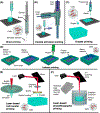Advances in 3D bioprinting for urethral tissue reconstruction
- PMID: 38057169
- PMCID: PMC11669461
- DOI: 10.1016/j.tibtech.2023.10.009
Advances in 3D bioprinting for urethral tissue reconstruction
Abstract
Urethral conditions affect children and adults, increasing the risk of urinary tract infections, voiding and sexual dysfunction, and renal failure. Current tissue replacements differ from healthy urethral tissues in structural and mechanical characteristics, causing high risk of postoperative complications. 3D bioprinting can overcome these limitations through the creation of complex, layered architectures using materials with location-specific biomechanical properties. This review highlights prior research and describes the potential for these emerging technologies to address ongoing challenges in urethral tissue engineering, including biomechanical and structural mismatch, lack of individualized repair solutions, and inadequate wound healing and vascularization. In the future, the integration of 3D bioprinting technology with advanced biomaterials, computational modeling, and 3D imaging could transform personalized urethral surgical procedures.
Keywords: 3D bioprinting; biomaterials; tissue engineering; urethra; urological disease.
Published by Elsevier Ltd.
Conflict of interest statement
Declaration of interests N.A., is a member of the journal’s advisory board and affirms that this affiliation did not influence the idea, execution, or interpretation of the article. N.A. holds equity in GelMEDIX Inc.; R.S. holds equity in Protean Surgical Instruments. The remaining authors declare no interests.
Figures





References
-
- Baskin LS and Ebbers MB (2006) Hypospadias: anatomy, etiology, and technique. J. Pediatr. Surg. 41, 463–472 - PubMed
-
- Santucci RA et al. (2007) Male urethral stricture disease. J. Urol. 177, 1667–1674 - PubMed
-
- Barbagli G et al. (2010) Morbidity of oral mucosa graft harvesting from a single cheek. Eur. Urol. 58, 33–41 - PubMed
Publication types
MeSH terms
Substances
Grants and funding
LinkOut - more resources
Full Text Sources
Medical

